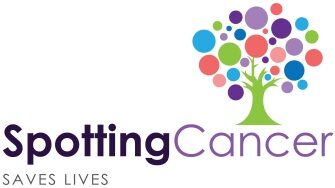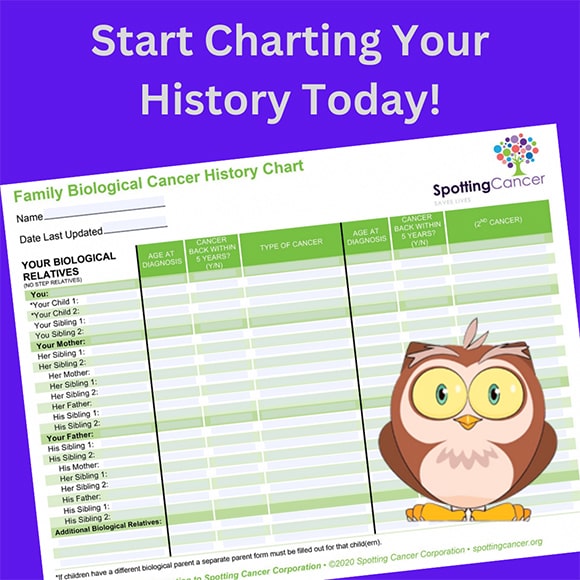Just like you would prepare an emergency plan and contacts for your family, you should chart out your biological family’s cancer history.
Biological family members share the same genes – not just in the way they look, but also in genetic makeup that can determine their health and well being. Being aware of your biological family history can help you better manage your long-term well-being.
Today, it’s estimated that 5 to 10 percent of cancer is hereditary. With the help of your biological family’s history, your medical team can evaluate you and determine which tests/screenings you should have and at what age to start them. And remember, you do not know if you fall into the 5-10% that will inherit cancer from your family or if you are in the 90-95% that won’t develop cancer due to family history so it is important to be proactive until conclusive testing is completed.
Below, you’ll find an interactive chart to record the information you gather about your biological family’s cancer history. It’s advised that once you have completed this download to then give it to your medical team.
Get to Know Your Biological Family History
Fill out our biological family cancer history chart
- Biological Family cancer history 3 generations
back
- Fill out the information about the cancer history of your first-degree relatives (parents, children, and full siblings) and second-degree relatives (grandparents, uncles/aunts, nieces/nephews, grandchildren).
- If you were adopted; ask your adoptive parents if they have any medical information from your biological parents.
- Which type of cancer
- If any of your relatives had cancer; you should collect information about what type of cancer(s) they had.
- How many times someone in your biological family has had cancer
- Knowing the number of times your biological family members have had cancer can help determine your chances of getting cancer.
- Remember, the risk of getting certain types of cancer, such as breast and ovarian cancer, is higher if you have a close relative who has developed the condition.
- If your relatives have had the same type of cancer or different cancers caused by the same gene fault, you may be at higher risk of getting cancer.
- Also, if a single person in your biological family has more than one type of cancer (like a woman with both ovarian and breast cancer), you may be at a higher risk of having the same condition.
- Age when diagnosed
- You may be at a higher risk of developing cancer if your biological family member developed the condition when they were young—say, below 40 years.
- Which relative had cancer
- Cancer in a close relative, like a parent or sibling, is a concern
- Even if cancer resulted from a gene mutation, the chances of it getting passed on to you would reduce with more distant relatives.
- How many years in remission
- Cancer remission is when the cancer symptoms have lessened or are undetectable.
- Being in remission doesn’t mean you are cancer free. Even if a relative has been in remission for a long time, that doesn’t mean you are not at risk of getting the disease.
What Do I Need to Do Next
Upon completing the form, you should:
- Give a copy to your medical teamand biological family members
- This information can help your medical team determine how best to ensure your long-time well-being. Similarly, your biological family members can determine if they need to work with a medical team and take measures to ensure their long-term health.
- Work with a doctor to determine if you need testing or screening
- Depending on what your biological family cancer tree looks like, your doctor may decide to conduct tests and screening to identify any signs of cancer in your body.
- Discuss the pros and cons of genetic testingfor you and your biological family
- While genetic testing has some benefits, such as giving your doctor the ability to use preventive medicine to reduce your risk of getting cancer, it also has some demerits, such as identifying a mutation in a rare high-risk gene, even when a patient doesn’t have a biological family history of that hereditary cancer syndrome.
- As such, you should discuss the pros and cons of genetic testing with your doctor before agreeing to go through with the procedure.
- Have a baseline to work from
- With a personal baseline, you’ll be able to better track your exams and how they’ve affected your body.
- Have a plan in place to be vigilant and get monitored regularly
- The plan should clearly outline the scheduled doctor visits, screenings, and diagnostic tests
- Update the cancer family history chart as needed
- You should update the information in your chart as your biological family’s cancer history changes.
- Join Oakley and the Cancer Detection Squad: This helps reduce cancer deaths through early detection and timely treatment.
Wrapping Up
Knowing your biological family’s history of cancer is important. It could help your medical team determine what tests you need to screen for cancer, when to start, and how often you should be tested. It can also help you and your doctor decide if genetic counseling and testing may be right for you.Help your medical team in evaluating you. Download the biological family history cancer chart and begin charting your biological family cancer history today.

